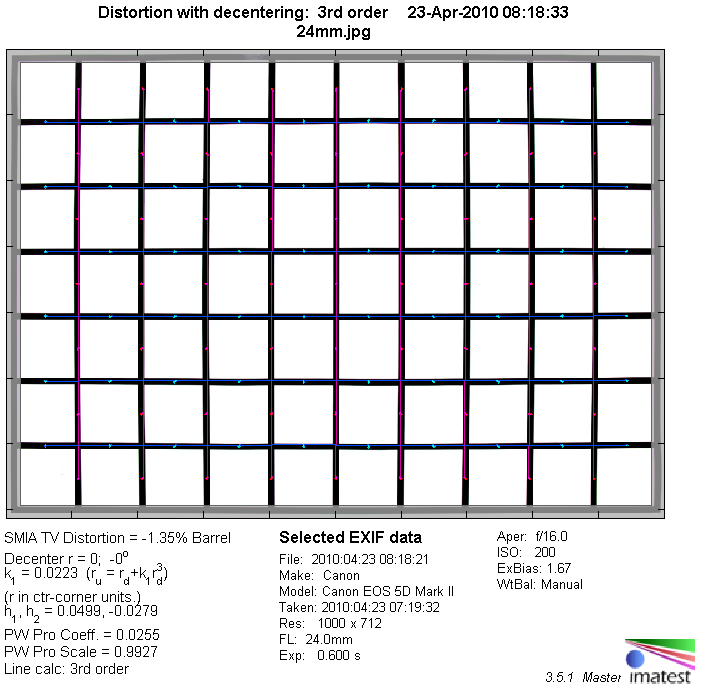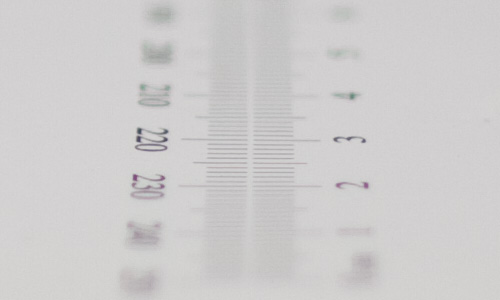|
Canon EF 24mm f/1.4 USM L II - Review / Test Report - Analysis |
|
Lens Reviews -
Canon EOS (Full Format)
|
|
Page 2 of 3

Distortion
The lens generates slight to moderate barrel distortion (~1.4%) which is pretty good for a moderate ultra-wide angle lens.

The chart above has a real-world size of about 120x80cm.
Vignetting
Vignetting at large apertures is a weak spot on full format cameras and the EF 24mm f/1.4 II has its share
of problems here. At f/1.4 images show a very extreme amount of vignetting (>3EV) which will be easily
visible in all images. The amount of edge shading is still very hefty at f/2 so it's generally a good idea
to stop down to f/2.8 if this is a problem for your application. The aspect is not really field relevant
anymore from f/5.6 onwards.

Here're some sample images:
| f/1.4 | f/2 |
 |
MTF (resolution)
The EF 24mm f/1.4 USM L II produced a roller-coaster ride regarding its resolution characteristic
across the tested aperture range. The center performance is perfectly fine but the critical borders/corners
aren't overly impressive at f/1.4 - the borders are acceptable whereas the extreme corners are downright soft
here. The situation improves slightly at f/2 but you really need to stop down to f/2.8 to get a decent resolution
across the image frame. The good news is that the global quality is great between f/4 and f/8 - the center is especially outstanding at f/4. Diffraction is limiting the performance at f/11 but that's a physical effect and not a flaw of the lens.
Some keen users may note that the LW/PH figures exceed the resolution of the sensor and as such Nyquist - see this document (bottom) for more details about the procedure if you'd like to dive into this. Imatest can look a bit beyond the sensor resolution by taking some additional parameters into account.
Please note that the MTF results are not directly comparable across the different systems!
Below is a simplified summary of the formal findings. The chart shows line widths per picture height (LW/PH) which can be taken as a measure for sharpness.
If you want to know more about the MTF50 figures you may check out the corresponding Imatest Explanations
Chromatic Aberrations (CAs)
Lateral CAs (visible as color shadows at harsh contrast transitions) can reach an average CA pixel width
of around 1 pixels at the image borders. This is pretty good for such a lens within the full format
scope.

Bokeh
The bokeh (the quality of the out-of-focus blur) is a primary aspect for an ultra large aperture lens.
However, the Canon does not really impress here. It is, of course, capable of producing a very shallow
depth-of-field but the produced blur is somewhat on the rough side especially at f/1.4. The bokeh is
a bit better at f/2. To be fair - this is all not overly surprising because wide-angle lenses with
aspherical elements are rarely good renowned for the quality of the bokeh.

Bokeh Fringing / Longitudinal Chromatic Aberrations (LoCA)
Bokeh fringing at large aperture is a problem which is often not well corrected even by the very best
lenses. The Canon produces quite some purple to green out-of-focus halos at f/1.4 as well. The effect
decreases at f/2 and it's not really an issue anymore at f/2.8.
|
Move the mouse cursor over the f-stop marks below to observe the respective LoCAs
|
| f/1.4 |
f/2 |
f/2.8 |
f/4 |
|

|
|